Becker Vineyards 2009 Provençal Rosé: Dry and Pink Soothes the Scorch of Summertime Heat
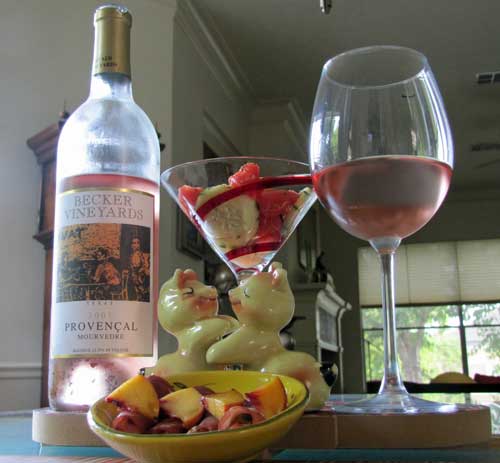
This year, we got through July with nary a temperature above ninety-five. But then, August came with a fiery flourish that seemed straight from the dominion of Hades, stoking up the temperatures up to the century mark and beyond.
I was looking for relief from the heat, a respite if just for an afternoon last weekend when I joined several other wine aficionados at Becker Vineyards (www.beckervineyards.com) to participate in a panel under the auspices of Culinaria (previously known as San Antonio’s New World Wine and Food Festival – http://culinariasa.com).
The panel themed, Rambling Rosé, was organized and led by Steve Krueger, the Sommelier at the Westin La Canterra (www.westinlacantera.com). The panelists included myself along with Steve, Dr. Richard Becker (Becker Vineyards) with his two adult sons, Joe Abruzzo (Houston-based restaurant/beverage consultant – www.genuinehc.com), Bonny Walker and John Griffin from Savor SA and San Antonio Taste Magazine (http://www.savorsa.com/2010/08/pink-is-cool-at-rambling-rose-becker-vineyards/).
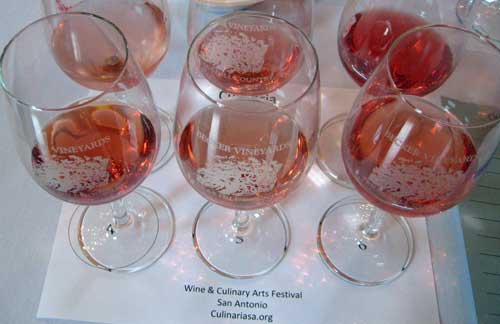
The wines in this panel program were tasted blind. The “wine experts” on the panel guided the assembled “tasters” through a pink palate of flavors. It sounded like fun, something both educational and tasty! Before leaving for the event, I had a moment of hesitation. I had never participated in a full flight of Rosés before that brought up the thought… Is there really that much variation in a flight of six pink wines? I hoped that I had more to say that just “Looks pink, smells pink and tastes pink”.
The tastes for the afternoon included the following six wines: Robert Oatley Rosé, Angove’s Nine Vines Rosé (both from Australia), Menage á Trois and Bonterra Rosés from California, and McPherson Rosé of Syrah and Becker Vineyards Provençal from Texas. We did not know the order that was switched with each of three presentations. The only thing perceptible from the presentation of the wines was that they captured a wide range of colors, from salmon pink, to rosy red to verging on magenta.
Program organizer was Steve Krueger, Sommelier at the Westin Resort at La Canterra in San Antonio, Texas (www.westinlacantera.com). The program sponsor was Culinaria (formerly the New World Wine and Food Festival). The event, called “Rambling Rosé”, coincided with the release of the 2009 Becker Vineyards Provençal.
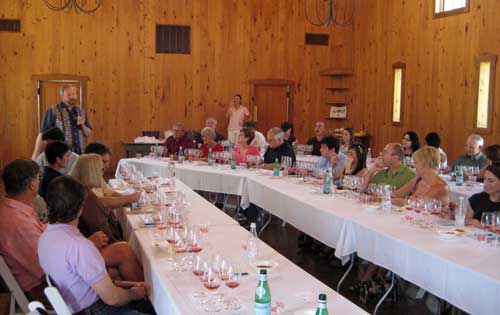
I had figuratively cut my teeth on Rosé wines back in college, but then they were sweet and sparkling. My real education and the profound experience of what heights Rosés can reach happened to me in the south of France over a decade ago. In addition, I had just revisited the region of Provence last year. It was shear delight to savor their pink juice in seaside cafés in Nice and in a countryside villa or two. The climate and view were much like we experience in Texas…hot and a bit humid. The palm trees waving over me on the French Riviera and there were even a prickly pear cactus or two bordering the vineyards. The epicenter of the Rosé world was there before me in the French wine country bounded by the Appellation of Bandol near the seaside city of Marseilles. Here is where I learn the essence of dry Rosé from its quintessential salmon pink hue to it red fruit character to its bracingly crisp finish. This combination of wine characteristics seemed to immediately drop the outdoor temperature by ten degrees with one sip.
The flight of wines presented was predominantly new world in origin coming from Australia, California and Texas. Most were overly fruity to the point where they could not be considered dry. We surmised that some like the Bonterra and the Menage á Trois Rosés were, in fact, hanging around a residual sugar content of about one percent, which perhaps made them more off-dry than truly dry. I do not immediately pass off wines with residual sugar content, but they make better poolside quaffs than wines that pair well with foods. I was surprised that one of the wines, Bonterra Rosé appeared as a Rosé made from a blend of red and white wines. In fact, I was able to discern a rather pungent aroma characteristic of the white grape Gewürztraminer. It surprised me when Steven Krueger told us the names of the wines and mentioned that the Bonterra actually did have this grape in the blend.
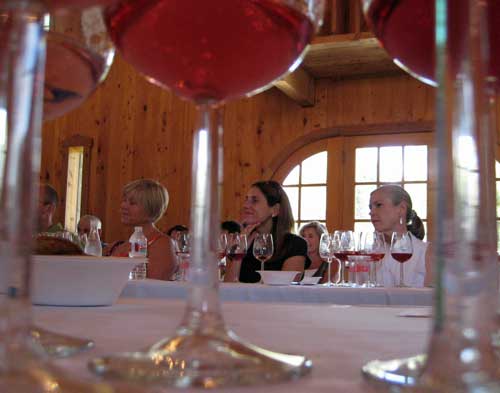
By far, the more conventional (or I should say traditional) method of making Rosé wines is to use the juice from red grapes, the same ones that make hearty red wines. However, in the case of making Rosé, the grapes are pressed and the juice is left in contact with the grape skins for only a short period of time thus giving the wine its pink hue.
I was most impressed with one of the Rosé wines, it was a shade or two paler pink than most of the wines that aimed more at the red and purple end of the spectrum. It had a pink coloration, but the ever slightest of salmon hue, which to me was the more classic style I had learned when in the Appellation of Bandol in southern France. While paler in color than the rest of the wines, it had an elegant integration of fruit and acid with a complexity of earthy aromas and a light steely finish. By comparison, the bulk of the other wines were composed to feature the rope fruit, but with little else. They were monochromatic where as this wine was more like the classic Rosé that I tasted on the Mediterranean shores. In fact, I commented that, “This wine is like Bandol in the glass, what I think is the gold standard for what dry Rosés should be.”
I later found out that the wine that I preferred, as did most of the panel and many in the audience participating in the tasting, was the Becker Vineyards 2009 Provençal Rosé. I was so captivated by this wine that after the afternoon’s events, I nabbed a bottle and perused it.
What captured my eye was the single word “Mourvèdre” on the front label. It is no wonder that this wine captured the essence of Bandol, as this appellation is based on the Mourvèdre grape. I have read accounts of wines from Bandol from as far back as the sixteen century that expound the virtues of their wines, all based on Mourvèdre. Following the devastation of Phylloxera in the 1800s, Appellation Bandol (http://www.vinsdebandol.com/fr/aoc-bandol.html&lang=en) like many other French regions were replanted with lesser, but higher production varieties of grapes. It was not until after World War II that the Appellation of Bandol started to slowly work back to growing Mourvèdre as their dominant grape with Grenache and Cinsault in supporting roles.
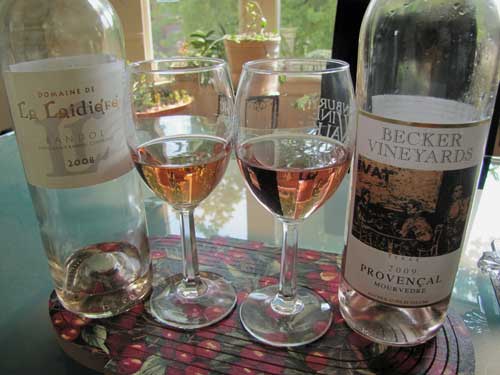
When returning to Houston, I brought a bottle of the Becker Vineyards 2009 Provençal Rosé back with me. Once here, I found a bottle of a true Bandol AOC Rosé from Domaine La Laidiere (www.laidiere.com) imported by Bandol Wines (http://bandolwines.com). The two wines could not have been more similar. Both had the classic salmon pink, with the Becker Provençal just a tone further to pink. Both were dry and refreshing, with the Becker wine having a tad more dominant fruit while the La Ladiere was a bit more steely sharp on the finish. This may have come from the Becker winemaking technique, but perhaps even more likely from the greater dominance of the Mourvedre grapes in the Becker Rosé over the lesser amount used in the La Laidiera Rosé where the balance was composed of Grenache and Cinsault. I am in pursuit of more Rosés of Bandol origin, with my sights set on something that contains s still higher percentage of Mourvèdre.
My spontaneous statement on the panel about the Becker Vineyards Provençal seemed to apply even more now that I had a direct comparison with a Rosé of AOC Bandol pedigree that could better support my premise…
The Becker Vineyards 2009 Provençal Rosé IS like having Bandol in the glass…. the gold standard for what dry Rosés should REALLY be.
And, what’s best of all, without me, or my money, having to leave Texas. Give it a try!
Even better, try them both, the Bandol and its Texas-brethern, only then will you start to really understand and appreciate what Texas wine is all about.

Be the first to comment